中英道歉语异同分析
- 格式:doc
- 大小:117.50 KB
- 文档页数:11
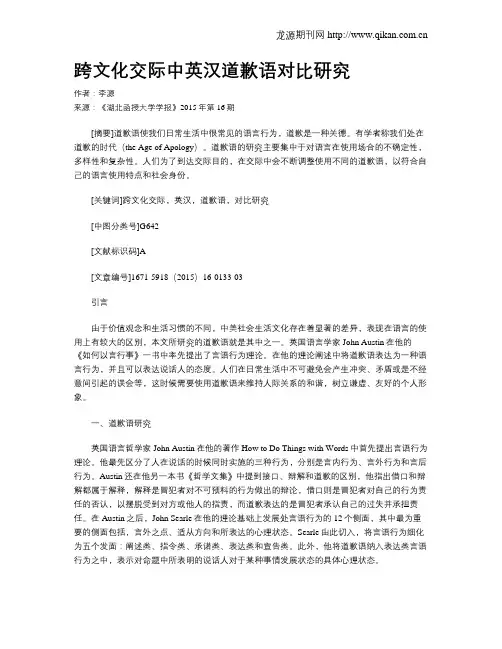
跨文化交际中英汉道歉语对比研究作者:李源来源:《湖北函授大学学报》2015年第16期[摘要]道歉语使我们日常生活中很常见的语言行为,道歉是一种关德。
有学者称我们处在道歉的时代(the Age of Apology)。
道歉语的研究主要集中于对语言在使用场合的不确定性,多样性和复杂性。
人们为了到达交际目的,在交际中会不断调整使用不同的道歉语,以符合自己的语言使用特点和社会身份。
[关键词]跨文化交际,英汉,道歉语,对比研究[中图分类号]G642[文献标识码]A[文章编号]1671-5918(2015)16-0133-03引言由于价值观念和生活习惯的不同,中美社会生活文化存在着显著的差异,表现在语言的使用上有较大的区别,本文所研究的道歉语就是其中之一。
英国语言学家John Austin在他的《如何以言行事》一书中率先提出了言语行为理论。
在他的理论阐述中将道歉语表达为一种语言行为,并且可以表达说话人的态度。
人们在日常生活中不可避免会产生冲突、矛盾或是不经意间引起的误会等,这时候需要使用道歉语来维持人际关系的和谐,树立谦虚、友好的个人形象。
一、道歉语研究英国语言哲学家John Austin在他的著作How to Do Things with Words中首先提出言语行为理论。
他最先区分了人在说话的时候同时实施的三种行为,分别是言内行为、言外行为和言后行为。
Austin还在他另一本书《哲学文集》中提到接口、辩解和道歉的区别,他指出借口和辩解都属于解释,解释是冒犯者对不可预料的行为做出的辩论,借口则是冒犯者对自己的行为责任的否认,以摆脱受到对方或他人的指责,而道歉表达的是冒犯者承认自己的过失并承担责任。
在Austin之后,John Searle在他的理论基础上发展处言语行为的12个侧面,其中最为重要的侧面包括,言外之点、适从方向和所表达的心理状态。
Searle由此切入,将言语行为细化为五个发面:阐述类、指令类、承诺类、表达类和宣告类。
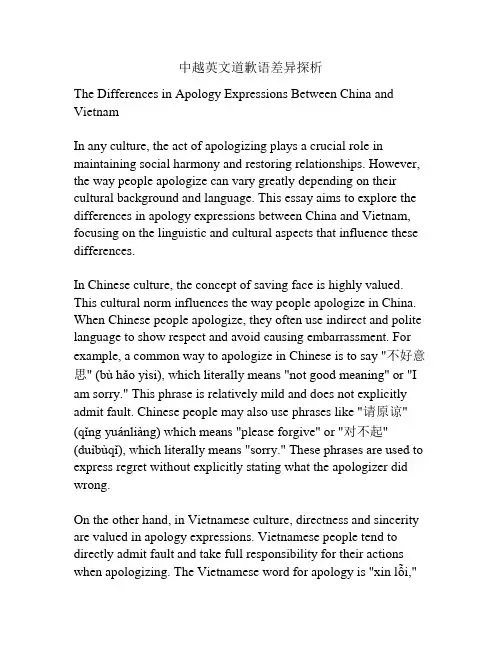
中越英文道歉语差异探析The Differences in Apology Expressions Between China and VietnamIn any culture, the act of apologizing plays a crucial role in maintaining social harmony and restoring relationships. However, the way people apologize can vary greatly depending on their cultural background and language. This essay aims to explore the differences in apology expressions between China and Vietnam, focusing on the linguistic and cultural aspects that influence these differences.In Chinese culture, the concept of saving face is highly valued. This cultural norm influences the way people apologize in China. When Chinese people apologize, they often use indirect and polite language to show respect and avoid causing embarrassment. For example, a common way to apologize in Chinese is to say "不好意思" (bù hǎo yìsi), which literally means "not good meaning" or "I am sorry." This phrase is relatively mild and does not explicitly admit fault. Chinese people may also use phrases like "请原谅" (qǐng yuánliàng) which means "please forgive" or "对不起"(duìbùqǐ), which literally means "sorry." These phrases are used to express regret without explicitly stating what the apologizer did wrong.On the other hand, in Vietnamese culture, directness and sincerity are valued in apology expressions. Vietnamese people tend to directly admit fault and take full responsibility for their actions when apologizing. The Vietnamese word for apology is "xin lỗi,"which is used in various contexts and situations. This phrase is straightforward and translates directly to "I am sorry." Vietnamese people believe in the importance of sincerity and taking ownership of one's mistakes when apologizing.The linguistic differences between Chinese and Vietnamese also influence the way people apologize in these two cultures. Chinese is a tonal language with many homophones, which allows for various interpretations and layers of meaning in apology expressions. This linguistic feature is reflected in the indirect and ambiguous way Chinese people apologize. Vietnamese, on the other hand, is a tonal language with fewer homophones, which leads to a more direct and explicit way of apologizing.Additionally, the cultural values and historical background of China and Vietnam contribute to the differences in apology expressions. Chinese culture places a strong emphasis on hierarchy and respecting authority. This cultural aspect influences the way people apologize, as they may use more polite and deferential language when apologizing to someone higher in the social hierarchy. Vietnamese culture, on the other hand, tends to be more egalitarian, emphasizing egalitarianism and equality. Vietnamese people may use language that is direct and equal when apologizing to others, regardless of their social status or position.Furthermore, historical conflicts and interactions between China and Vietnam have shaped their cultural norms and attitudes towards apology. China and Vietnam have had a complex relationship marked by both cooperation and conflict throughout history. This historical context is reflected in their apologyexpressions. Chinese people may feel hesitant to admit fault fully due to historical sensitivities and concerns about saving face. On the other hand, Vietnamese people may adopt a more direct and straightforward approach to apology influenced by historical experiences of colonization and the struggle for independence.In conclusion, while the act of apologizing is universal, the way people apologize in different cultures can vary significantly. In China, the concept of saving face and indirectness often influences how people apologize, using polite language that avoids explicit admission of fault. Vietnamese culture, on the other hand, values directness and sincerity, leading to more straightforward apologies that openly admit fault and take responsibility. Linguistic features and cultural values, as well as historical background, all contribute to these differences in apology expressions between China and Vietnam. Understanding and respecting these cultural differences can help promote effective communication and establish better understanding between people of different cultural backgrounds.。
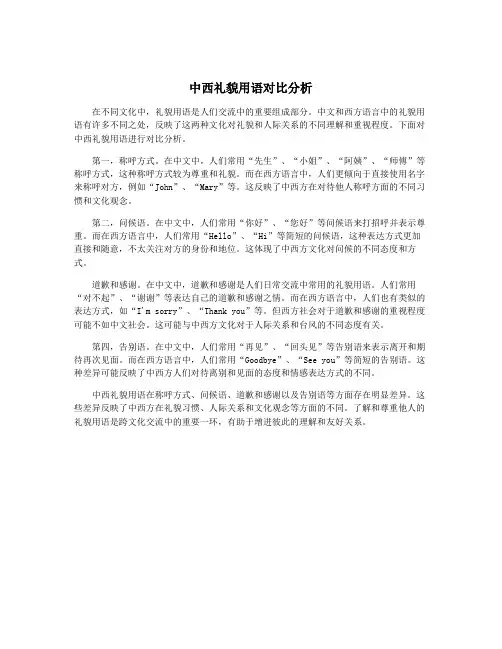
中西礼貌用语对比分析在不同文化中,礼貌用语是人们交流中的重要组成部分。
中文和西方语言中的礼貌用语有许多不同之处,反映了这两种文化对礼貌和人际关系的不同理解和重视程度。
下面对中西礼貌用语进行对比分析。
第一,称呼方式。
在中文中,人们常用“先生”、“小姐”、“阿姨”、“师傅”等称呼方式,这种称呼方式较为尊重和礼貌。
而在西方语言中,人们更倾向于直接使用名字来称呼对方,例如“John”、“Mary”等。
这反映了中西方在对待他人称呼方面的不同习惯和文化观念。
第二,问候语。
在中文中,人们常用“你好”、“您好”等问候语来打招呼并表示尊重。
而在西方语言中,人们常用“Hello”、“Hi”等简短的问候语,这种表达方式更加直接和随意,不太关注对方的身份和地位。
这体现了中西方文化对问候的不同态度和方式。
道歉和感谢。
在中文中,道歉和感谢是人们日常交流中常用的礼貌用语。
人们常用“对不起”、“谢谢”等表达自己的道歉和感谢之情。
而在西方语言中,人们也有类似的表达方式,如“I'm sorry”、“Thank you”等。
但西方社会对于道歉和感谢的重视程度可能不如中文社会。
这可能与中西方文化对于人际关系和台风的不同态度有关。
第四,告别语。
在中文中,人们常用“再见”、“回头见”等告别语来表示离开和期待再次见面。
而在西方语言中,人们常用“Goodbye”、“See you”等简短的告别语。
这种差异可能反映了中西方人们对待离别和见面的态度和情感表达方式的不同。
中西礼貌用语在称呼方式、问候语、道歉和感谢以及告别语等方面存在明显差异。
这些差异反映了中西方在礼貌习惯、人际关系和文化观念等方面的不同。
了解和尊重他人的礼貌用语是跨文化交流中的重要一环,有助于增进彼此的理解和友好关系。
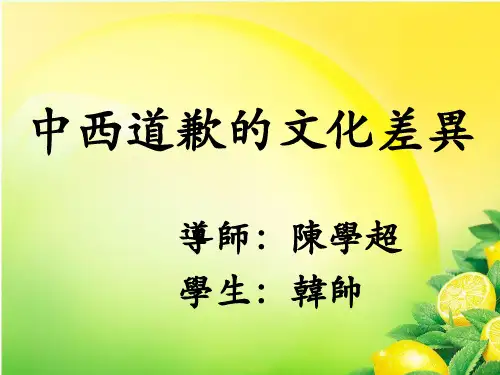
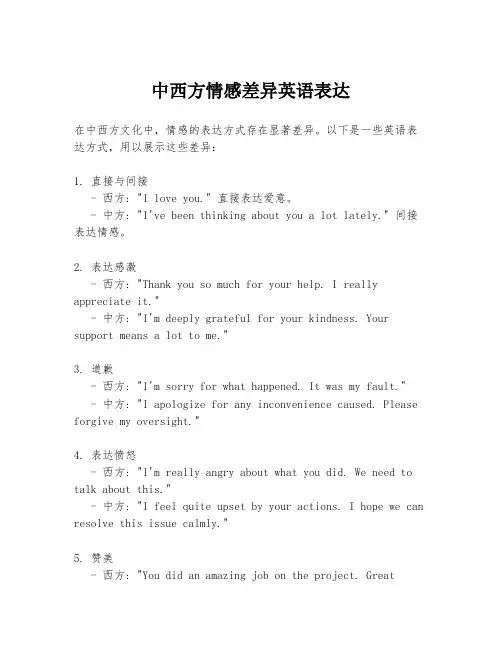
中西方情感差异英语表达在中西方文化中,情感的表达方式存在显著差异。
以下是一些英语表达方式,用以展示这些差异:1. 直接与间接- 西方: "I love you." 直接表达爱意。
- 中方: "I've been thinking about you a lot lately." 间接表达情感。
2. 表达感激- 西方: "Thank you so much for your help. I really appreciate it."- 中方: "I'm deeply grateful for your kindness. Your support means a lot to me."3. 道歉- 西方: "I'm sorry for what happened. It was my fault."- 中方: "I apologize for any inconvenience caused. Please forgive my oversight."4. 表达愤怒- 西方: "I'm really angry about what you did. We need to talk about this."- 中方: "I feel quite upset by your actions. I hope we can resolve this issue calmly."5. 赞美- 西方: "You did an amazing job on the project. Greatwork!"- 中方: "Your efforts are commendable. The results are truly impressive."6. 表达悲伤- 西方: "I'm feeling really sad about the news. It's a tough time."- 中方: "This news has brought a heavy heart. I'm deeply affected."7. 表达喜悦- 西方: "I'm so happy for you! Congratulations on your success."- 中方: "I'm delighted to hear about your achievement. It's a joyous occasion."8. 表达关心- 西方: "Are you okay? Can I do anything to help?"- 中方: "How are you feeling? Is there anything I can assist you with?"9. 表达尊重- 西方: "I respect your decision and will support you." - 中方: "I hold your opinion in high regard and will follow your guidance."10. 表达友谊- 西方: "You're a great friend, and I value our friendship."- 中方: "Our friendship is precious, and I cherish the bond we share."这些表达方式体现了文化差异对情感表达的影响,而了解这些差异有助于跨文化交流和理解。
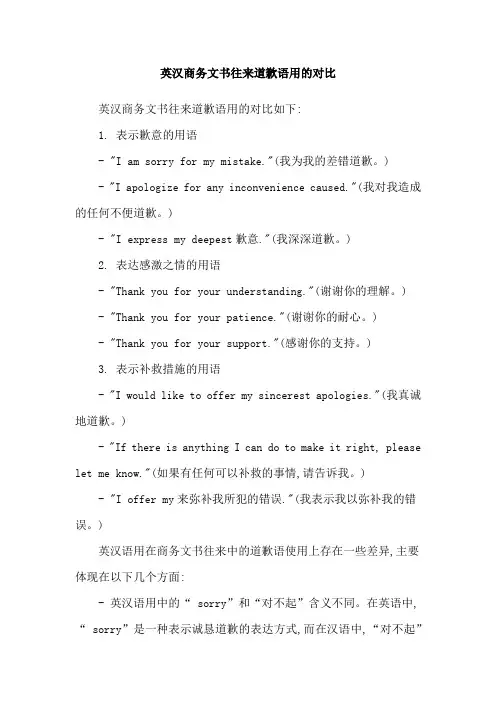
英汉商务文书往来道歉语用的对比英汉商务文书往来道歉语用的对比如下:1. 表示歉意的用语- "I am sorry for my mistake."(我为我的差错道歉。
)- "I apologize for any inconvenience caused."(我对我造成的任何不便道歉。
)- "I express my deepest歉意."(我深深道歉。
)2. 表达感激之情的用语- "Thank you for your understanding."(谢谢你的理解。
)- "Thank you for your patience."(谢谢你的耐心。
)- "Thank you for your support."(感谢你的支持。
)3. 表示补救措施的用语- "I would like to offer my sincerest apologies."(我真诚地道歉。
)- "If there is anything I can do to make it right, please let me know."(如果有任何可以补救的事情,请告诉我。
)- "I offer my来弥补我所犯的错误."(我表示我以弥补我的错误。
)英汉语用在商务文书往来中的道歉语使用上存在一些差异,主要体现在以下几个方面:- 英汉语用中的“ sorry”和“对不起”含义不同。
在英语中,“ sorry”是一种表示诚恳道歉的表达方式,而在汉语中,“对不起”更多地表示一种礼貌的道歉方式。
- 英汉语用中的“ inconvenience”和“不便”含义也不同。
在英语中,“inconvenience”指的是某种不便或困难,而汉语中,“不便”更多的指的是某种不便或不便的情况。

道歉信的中英对照范例和对比分析道歉信是一种表达歉意和道歉的正式信函,常用于商务和个人场合。
在国际交流中,中英文化差异导致了道歉信的写作方式和表达方式上的差异。
本文将以中英对照的方式,分析道歉信的范例,并对比两种文化中的差异。
范例一:亲爱的李先生,非常抱歉给您带来了不便。
我写此信是为了向您表达我对上次会议迟到的歉意。
事实上,我原本计划提前出发,但因为交通拥堵,我遇到了无法预料的延误。
我深知这对您和其他与会人员造成了困扰,对此我深感抱歉。
我对我的疏忽感到非常愧疚,我将确保以后不再发生类似的情况。
我会更加注意时间管理,并提前规划行程,以确保准时到达。
再次对给您带来的不便表示道歉,希望您能理解我的困境。
如果有任何补救措施或者赔偿方式,我都会尽力满足您的要求。
衷心感谢您的理解和宽容。
此致敬礼张三Dear Mr. Li,I am writing this letter to express my sincere apologies for being late to the meeting last time, and any inconvenience it may have caused you.In fact, I had planned to leave early, but due to unexpected traffic congestion, I encountered a delay. I deeply regret the trouble this caused you and other participants.I feel extremely guilty for my carelessness, and I will ensure that similar incidents do not happen again. I will pay more attention to time management and plan my schedule in advance to ensure punctuality.Once again, I apologize for the inconvenience caused and hope you can understand my situation. If there are any remedial measures or compensations I can provide, I will do my best to meet your requirements.Thank you sincerely for your understanding and tolerance.Yours faithfully,Zhang San范例二:亲爱的朋友们,我写这封信是为了向大家道歉。
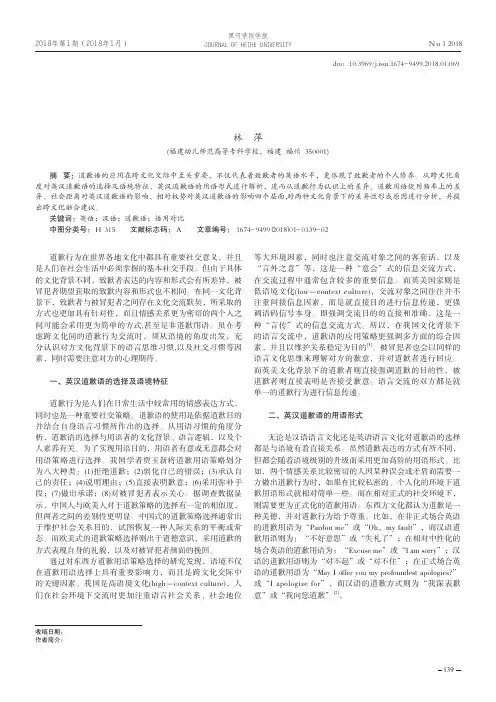
139道歉行为在世界各地文化中都具有重要社交意义,并且是人们在社会生活中必须掌握的基本社交手段。
但由于具体的文化背景不同,致歉者表达的内容和形式会有所差异,被冒犯者期望获取的致歉内容和形式也不相同。
在同一文化背景下,致歉者与被冒犯者之间存在文化交流默契,所采取的方式也更加具有针对性,而且情感关系更为密切的两个人之间可能会采用更为简单的方式,甚至是非道歉用语。
虽在考虑跨文化间的道歉行为交流时,须从语境的角度出发,充分认识对方文化背景下的语言思维习惯,以及社交习惯等因素,同时需要注意对方的心理期待。
一、英汉道歉语的选择及语境特征道歉行为是人们在日常生活中较常用的情感表达方式,同时也是一种重要社交策略。
道歉语的使用是依据道歉目的并结合自身语言习惯所作出的选择。
从用语习惯的角度分析,道歉语的选择与用语者的文化背景、语言逻辑,以及个人素养有关。
为了实现用语目的,用语者有意或无意都会对用语策略进行选择。
我国学者贾玉新将道歉用语策略划分为八大种类:(1)拒绝道歉;(2)弱化自己的错误;(3)承认自己的责任;(4)说明理由;(5)直接表明歉意;(6)采用弥补手段;(7)做出承诺;(8)对被冒犯者表示关心。
据调查数据显示,中国人与欧美人对于道歉策略的选择有一定的相似度,但两者之间的差别性更明显。
中国式的道歉策略选择通常出于维护社会关系目的,试图恢复一种人际关系的平衡或常态。
而欧美式的道歉策略选择则出于道德意识,采用道歉的方式表现自身的礼貌,以及对被冒犯者颜面的挽回。
通过对东西方道歉用语策略选择的研究发现,语境不仅在道歉用语选择上具有重要影响力,而且是跨文化交际中的关键因素。
我国是高语境文化(high-context culture),人们在社会环境下交流时更加注重语言社会关系、社会地位等大环境因素,同时也注意交流对象之间的客套话,以及“言外之意”等,这是一种“意会”式的信息交流方式,在交流过程中通常包含较多的重要信息。
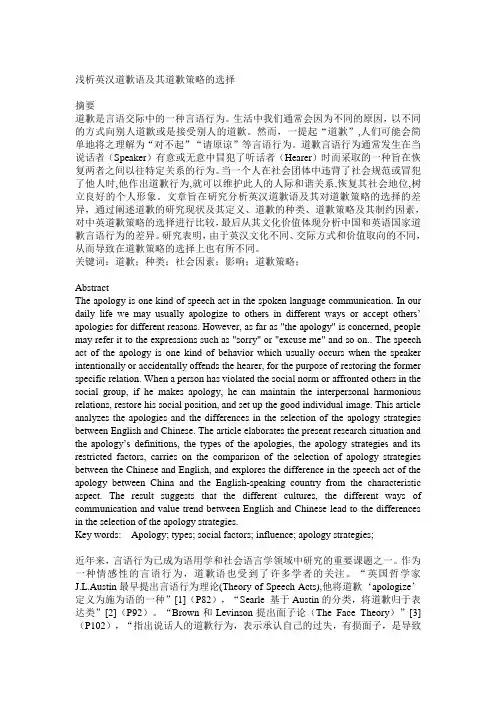
浅析英汉道歉语及其道歉策略的选择摘要道歉是言语交际中的一种言语行为。
生活中我们通常会因为不同的原因,以不同的方式向别人道歉或是接受别人的道歉。
然而,一提起“道歉”,人们可能会简单地将之理解为“对不起”“请原谅”等言语行为。
道歉言语行为通常发生在当说话者(Speaker)有意或无意中冒犯了听话者(Hearer)时而采取的一种旨在恢复两者之间以往特定关系的行为。
当一个人在社会团体中违背了社会规范或冒犯了他人时,他作出道歉行为,就可以维护此人的人际和谐关系,恢复其社会地位,树立良好的个人形象。
文章旨在研究分析英汉道歉语及其对道歉策略的选择的差异,通过阐述道歉的研究现状及其定义、道歉的种类、道歉策略及其制约因素,对中英道歉策略的选择进行比较,最后从其文化价值体现分析中国和英语国家道歉言语行为的差异。
研究表明,由于英汉文化不同、交际方式和价值取向的不同,从而导致在道歉策略的选择上也有所不同。
关键词:道歉;种类;社会因素;影响;道歉策略;AbstractThe apology is one kind of speech act in the spoken language communication. In our daily life we may usually apologize to others in different ways or accept others’ apologies for different reasons. However, as far as "the apology" is concerned, people may refer it to the expressions such as "sorry" or "excuse me" and so on.. The speech act of the apology is one kind of behavior which usually occurs when the speaker intentionally or accidentally offends the hearer, for the purpose of restoring the former specific relation. When a person has violated the social norm or affronted others in the social group, if he makes apology, he can maintain the interpersonal harmonious relations, restore his social position, and set up the good individual image. This article analyzes the apologies and the differences in the selection of the apology strategies between English and Chinese. The article elaborates the present research situation and the apology’s definitions, the types of the apologies, the apology strategies and its restricted factors, carries on the comparison of the selection of apology strategies between the Chinese and English, and explores the difference in the speech act of the apology between China and the English-speaking country from the characteristic aspect. The result suggests that the different cultures, the different ways of communication and value trend between English and Chinese lead to the differences in the selection of the apology strategies.Key words: Apology; types; social factors; influence; apology strategies;近年来,言语行为已成为语用学和社会语言学领域中研究的重要课题之一。
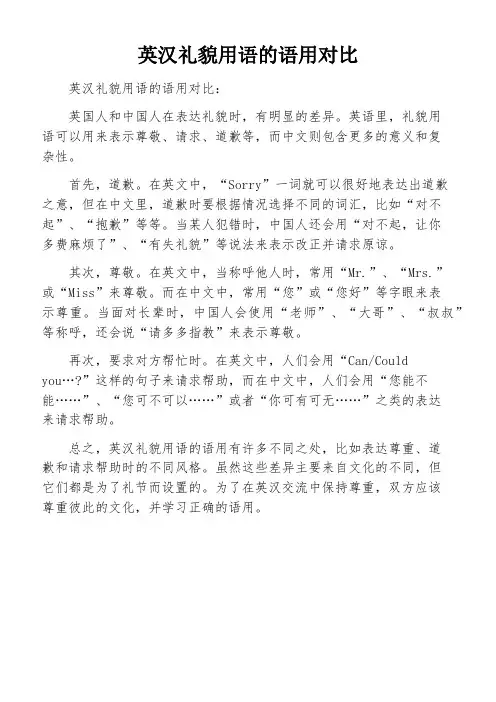
英汉礼貌用语的语用对比
英汉礼貌用语的语用对比:
英国人和中国人在表达礼貌时,有明显的差异。
英语里,礼貌用
语可以用来表示尊敬、请求、道歉等,而中文则包含更多的意义和复
杂性。
首先,道歉。
在英文中,“Sorry”一词就可以很好地表达出道歉
之意,但在中文里,道歉时要根据情况选择不同的词汇,比如“对不起”、“抱歉”等等。
当某人犯错时,中国人还会用“对不起,让你
多费麻烦了”、“有失礼貌”等说法来表示改正并请求原谅。
其次,尊敬。
在英文中,当称呼他人时,常用“Mr.”、“Mrs.”
或“Miss”来尊敬。
而在中文中,常用“您”或“您好”等字眼来表
示尊重。
当面对长辈时,中国人会使用“老师”、“大哥”、“叔叔”等称呼,还会说“请多多指教”来表示尊敬。
再次,要求对方帮忙时。
在英文中,人们会用“Can/Could you…?”这样的句子来请求帮助,而在中文中,人们会用“您能不能……”、“您可不可以……”或者“你可有可无……”之类的表达
来请求帮助。
总之,英汉礼貌用语的语用有许多不同之处,比如表达尊重、道
歉和请求帮助时的不同风格。
虽然这些差异主要来自文化的不同,但
它们都是为了礼节而设置的。
为了在英汉交流中保持尊重,双方应该
尊重彼此的文化,并学习正确的语用。
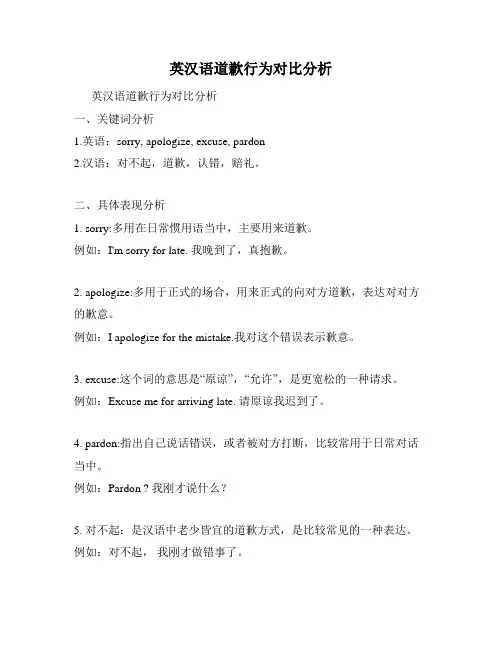
英汉语道歉行为对比分析
英汉语道歉行为对比分析
一、关键词分析
1.英语:sorry, apologize, excuse, pardon
2.汉语:对不起,道歉,认错,赔礼。
二、具体表现分析
1. sorry:多用在日常惯用语当中,主要用来道歉。
例如:I'm sorry for late. 我晚到了,真抱歉。
2. apologize:多用于正式的场合,用来正式的向对方道歉,表达对对方的歉意。
例如:I apologize for the mistake.我对这个错误表示歉意。
3. excuse:这个词的意思是“原谅”,“允许”,是更宽松的一种请求。
例如:Excuse me for arriving late. 请原谅我迟到了。
4. pardon:指出自己说话错误,或者被对方打断,比较常用于日常对话当中。
例如:Pardon ? 我刚才说什么?
5. 对不起:是汉语中老少皆宜的道歉方式,是比较常见的一种表达。
例如:对不起,我刚才做错事了。
6. 道歉:汉语里专门用来要求别人原谅或赔礼的话语,多指认错、认
罪的意思。
例如:我懂事的向你道歉。
7. 认错:指的是在向对方道歉时明确把责任推给自己。
例如:我愿意承认我错了。
8. 赔礼:多指在道歉后,承担相应责任后,给对方一定的补偿措施。
例如:我赔礼道歉,把责任转嫁给自己,并且会给你相应的补偿。
总的来说,英汉语道歉行为有相似也有不同之处,但其基本原则是礼貌、真诚,以及负责任,其最终目的都是希望以此表达对向对方歉意,维护彼此间的友谊。
英汉商务文书往来道歉语用的对比在商务场合,道歉是极为常见的社交技能之一。
面对因自身原因或其他原因而引发的误会、问题或不便,及时向他人道歉不仅能有效化解矛盾,更能维护双方关系的稳定发展。
下面就英语和中文常用商务道歉语做一对比。
一、致歉的语气及程度英语致歉语气通常比较委婉、客气。
典型的表达方式包括I apologize for (对…表示道歉)、I'm sorry that (对…表示抱歉)、Please forgive me for (请原谅我)等。
这类表达方式,通常用于对方不是特别熟悉,场合不是特别正式的情况。
相比之下,中文致歉语气及表达程度相对直接,通常带有一定的愧疚和歉意。
常见的表达方式包括对不起、不好意思、实在抱歉等。
这类表达方式,通常用于亲近程度较高、场合较为正式的情况。
具体表达要根据不同情形、人际关系以及道歉的程度和重要性做出相应调整,以达到贴切、得体的效果。
二、致歉的口吻及措辞英文道歉通常偏向于形式化、平稳,纯文本情况下缺乏表情和语气的情况下,需要在语言层面上表达真心歉意。
句式上常见的表达方式为:I'm truly sorry (我真的很抱歉)、Please accept my apologies (请接受我的道歉)、I regret to inform you that (很遗憾地通知您)等。
中文道歉则更注重口吻和措辞,希望通过语言、表情、动作等传递出真挚的歉意;缺乏表情和语气的文字通讯中更会使用感叹词和修饰词来强调歉意。
常见的表达方式包括:真的太对不起了、请原谅我的不周之处、很抱歉给你带来了困扰等。
三、致歉的态度和立场英文道歉注重委婉、客气的表现方式,在表达道歉时,通常要考虑自己的口气和态度,要表现出自己的歉意、尊重和关心。
当然,对方的感受和反应也是需要及时关注和反馈的,以便进行适当调整。
相比之下,中文道歉则更强调自我否定和委曲求全。
一些极端情况下,道歉方可能会表现出过分的谦卑和自责,甚至提出明显不实的要求和承诺。
课题专业探讨[摘要]道歉是英汉语言交际中经常出现的一种行为。
英汉道歉语使用有所不同,分析其中差异及背后的认知与文化因素帮助非本族语学习者选择恰当的道歉策略,避免交际错误。
[关键词]英汉;道歉语;文化;认知[中图分类号]H313[文献标志码]A [文章编号]2096-0603(2018)31-0023-01英汉道歉语对比研究①徐家婷,钱轶群*(常熟理工学院,江苏常熟215500)道歉是修复人际关系的润滑剂,在中西文化中都有重要的交际意义。
但是,由于中西方价值观和文化背景的差异,英汉道歉言语行为存在诸多差异,近年来引起了众多语言学者的重视。
一、道歉语研究综述美国著名的社会语言学家Erving Goffman (1970)在20世纪50年代末期提出了著名的面子理论。
他认为面子是社会交际中的一种仪式化行为。
“面子”这一概念代表个人行为符合特定的社会规范,并借此获得社会支持。
他将道歉言语行为比作处理社会关系的一剂良药。
在Goffman 的基础上,Brown 和Levinson (1987:187)为道歉阐释加入了礼貌元素,他们认为道歉是一种交际活动,在这一活动中,道歉者要表现出礼貌。
这种礼貌不完全停留在言语表达的层面,更重要的是关注到了被冒犯者的面子需求。
二、道歉语的使用策略Olshtain 和Cohen 将道歉策略归为五类:(1)明确表达歉意;(2)解释、辩解;(3)承认应付责任;(4)补偿;(5)保证。
这些策略在英汉道歉语中具有很高的相似度。
但在具体的策略选择方面,两者之间还有比较明显的差异,这主要归因于不同的文化背景、社会语境和民族心理。
无论是英语还是汉语,道歉的表达形式都十分丰富,具体形式的选择根据语境和语用习惯来决定,总的来说,在冒犯程度比较轻、场合比较随意的情况下,言语形式均比较简单。
汉语中常用“不好意思”“抱歉”等,而英语中常见“Excuse me ”“Pardon me ”等。
但在较正式的场合或冒犯行为较严重,道歉言语的使用更复杂,语气更诚恳,表达歉意的程度也更深。
中西礼貌用语对比分析中西礼貌用语是指人们在日常交往中,表达彼此尊重和友好的话语和表情。
在中西方两种文化的礼貌用语中,存在许多的差异。
下面,我们将分别从语言、手势和行为方面对中西礼貌用语进行对比分析。
语言方面:在中文礼貌用语中,常常使用“您好”、“对不起”、“请问”、“谢谢”等表达方式。
这些词语在中文中是相对正式的表达方式,在日常交谈中也被广泛使用。
例如,当遇到陌生人时,我们通常会使用“您好”来表示尊重和礼貌。
而“对不起”和“谢谢”则是用于表示歉意和感谢的常用用语。
而在西方礼貌用语中,常用的表达语言有“Hello”、“Excuse me”、“Please”、“Thank you”等。
这些词语也是相对正式的表达方式,在日常生活中也是被广泛使用的。
例如,当询问某个信息时,我们通常会使用“Excuse me, may I ask…”这样的表达方式来表示礼貌。
手势方面:在中文礼貌用语中,面带微笑、礼貌道别、握手等都是常见的礼貌手势。
例如,在中国,握手是一种表示友好和尊重的常见礼仪。
当与长辈或者同事等人见面时,握手是一种礼貌行为,可以显示出对对方的尊重和礼貌。
行为方面:在中文礼貌用语中,礼让别人、尊敬长辈、关心他人等都是常见的礼貌行为。
例如,在中国,礼让是一种常见的礼貌行为。
让座、拦门、借笔等都是小小的行为,但都能让人感受到尊重和关心。
总体来说,中西礼貌用语虽然存在一定的差异,但都含有一种共同的语言、手势和行为方式。
无论是哪种文化礼仪,都是在表达人们对彼此的尊重和友好的情感。
因此,我们在不同的场合、不同的文化环境下,应该根据实际情况,恰当地应用适当的礼貌用语来表达我们的尊重和友好。
中国英语学习者汉英道歉语使用情况分析每种都有独特的礼貌策略,全盘照搬某一文化的礼貌策略可能会致使来自另一文化的听话人的误读,下面是小编搜集整理的一篇关于中国学习者汉英道歉语使用情况分析的,供大家阅读查看。
一、引言道歉(apology)是一种“解决受害者面子需要、修补冒犯者不当行为并藉此维持双方交际平衡的言语行为”[1],属于表达性的言外行为(illocutionaryact)[2].它旨在引出受害者的原谅及为其提供支持[3].道歉行为在挽回受害者的面子同时威胁了冒犯者的面子,因为道歉时冒犯者往往主动降低自己的社会权力或地位以向对方道歉[4].刘思和刘润清[5]调查发现,中国英语学习者常常混淆英语道歉语Iamsorry和Excuseme的使用,并指出这是因为汉语的语用迁移在受试的中介语系统中发生了影响。
他们同时提出,英汉两种道歉语间的对等翻译(Iamsorry 对应“对不起”,Excuseme对应“请原谅”)不但引起了汉语道歉语的语用负迁移,还反映了中英文化观念和行为准则上的差异。
然而该调查并未通过访谈受试以验证其假设。
此外,在汉语表达中,Excuseme不一定都被翻译成“请原谅”,且“请原谅”在汉语口语中很少被使用,其出现频率远不及“对不起”那么高。
而在该项调查中,受试只有两种汉语道歉语的选项,分别是“请原谅”和“对不起”.根据汉语口语的使用习惯,可以推测大部分的受试会倾向于选择“对不起”而非“请原谅”.而这种选择偏向极可能是由母语的口语使用习惯引起的。
因此,本文试图探究不同水平的中国英语学习者汉英道歉策略及其道歉语(如I'msorry/Excuseme)的使用情况。
二、理论依据及相关研究跨文化语用学研究不同文化背景的人们之间的交际活动,重点在于对比分析不同文化中多种多样的语言活动。
Goffman[6]指出,I'msorry和Excuseme 在英语会话中都发挥修补功能,是说话者为自己的错误行为进行道歉所使用的话语。
跨文化交际中英汉道歉语对比研究[摘要]道歉语使我们日常生活中很常见的语言行为,道歉是一种关德。
有学者称我们处在道歉的时代(the Age of Apology)。
道歉语的研究主要集中于对语言在使用场合的不确定性,多样性和复杂性。
人们为了到达交际目的,在交际中会不断调整使用不同的道歉语,以符合自己的语言使用特点和社会身份。
[关键词]跨文化交际,英汉,道歉语,对比研究引言由于价值观念和生活习惯的不同,中美社会生活文化存在着显著的差异,表现在语言的使用上有较大的区别,本文所研究的道歉语就是其中之一。
英国语言学家John Austin在他的《如何以言行事》一书中率先提出了言语行为理论。
在他的理论阐述中将道歉语表达为一种语言行为,并且可以表达说话人的态度。
人们在日常生活中不可避免会产生冲突、矛盾或是不经意间引起的误会等,这时候需要使用道歉语来维持人际关系的和谐,树立谦虚、友好的个人形象。
一、道歉语研究英国语言哲学家John Austin在他的著作How to Do Things with Words中首先提出言语行为理论。
他最先区分了人在说话的时候同时实施的三种行为,分别是言内行为、言外行为和言后行为。
Austin还在他另一本书《哲学文集》中提到接口、辩解和道歉的区别,他指出借口和辩解都属于解释,解释是冒犯者对不可预料的行为做出的辩论,借口则是冒犯者对自己的行为责任的否认,以摆脱受到对方或他人的指责,而道歉表达的是冒犯者承认自己的过失并承担责任。
在Austin之后,John Searle在他的理论基础上发展处言语行为的12个侧面,其中最为重要的侧面包括,言外之点、适从方向和所表达的心理状态。
Searle由此切入,将言语行为细化为五个发面:阐述类、指令类、承诺类、表达类和宣告类。
此外,他将道歉语纳入表达类言语行为之中,表示对命题中所表明的说话人对于某种事情发展状态的具体心理状态。
关于道歉语的社会学研究始于社会学家Erving Goffman,是他提出了关于Face“面子”的概念,他认为面子是社会交往中人们有效地为自己赢得的正面的社会价值,即一种正面的Pub-lic image“公众形象”。
中英道歉语的使用差异及原因探析On the Differences of Apology Speech Act in Chinese and English摘要:道歉语是指能够为被冒犯的人挽回面子的一类语言。
在全球化日益增强的现代社会,中美合作与接触不断增多,但由于社会背景,文化及价值观念的不同,在跨文化交际中经常会出现一些误解甚至是冲突。
由于任何一种言语行为都反映了一定的社会准则和价值,并服务和维护那些价值观,因此,道歉言语行为能够像镜子一样折射出中美文化价值的差异。
所以,为了在跨文化交际中获得更好的交际目的,就有必要对中美道歉语进行跨文化研究。
本文首先介绍了道歉语研究的国内外现状,接着阐述了道歉语的种类、策略及制约因素,后对中英道歉策略的选择进行比较;最后从文化价值方面分析汉语和英语道歉语的差异。
通过研究表明, 由于英汉文化不同、交际方式和价值取向的不同, 道歉策略的选择上也相应的有所不同。
关键词:道歉语,文化差异,道歉策略Abstract: The language of apology is a special kind of speech which could provide support for the hearer who is offended. In the increasing global world, cooperation and contacts between Chinese and Americans are rapidly rising. However, along with this are the constant misunderstandings or even conflicts in cross-cultural communications due to different cultures and values. Because any speech act reflects a variety of culture norms and values and serves, the speech of apology can act as a mirror of certain cultural values in Chinese and English cultures. Therefore, in order to help people cultivate intercultural communicative competence and achieve better communicative purposes, it is necessary to study the language of apology between Chinese and Americans. This paper firstly introduces the study of research to the speech of apology both at home and abroad. Then the second part analyzes the different categories, strategies and restraining factors of the apologized speech. Finally, differences in the speech of language between English and Chinese language are probed from the aspects of different cultural values. Through the study, thefollowing conclusion is arrived: The cultural differences between English and Chinese, the different communication ways and value orientation directly lead to the different choices of apology strategies。
中英道歉语的使用差异及原因探析On the Differences of Apology Speech Act in Chinese and English摘要:道歉语是指能够为被冒犯的人挽回面子的一类语言。
在全球化日益增强的现代社会,中美合作与接触不断增多,但由于社会背景,文化及价值观念的不同,在跨文化交际中经常会出现一些误解甚至是冲突。
由于任何一种言语行为都反映了一定的社会准则和价值,并服务和维护那些价值观,因此,道歉言语行为能够像镜子一样折射出中美文化价值的差异。
所以,为了在跨文化交际中获得更好的交际目的,就有必要对中美道歉语进行跨文化研究。
本文首先介绍了道歉语研究的国内外现状,接着阐述了道歉语的种类、策略及制约因素,后对中英道歉策略的选择进行比较;最后从文化价值方面分析汉语和英语道歉语的差异。
通过研究表明, 由于英汉文化不同、交际方式和价值取向的不同, 道歉策略的选择上也相应的有所不同。
关键词:道歉语,文化差异,道歉策略Abstract: The language of apology is a special kind of speech which could provide support for the hearer who is offended. In the increasing global world, cooperation and contacts between Chinese and Americans are rapidly rising. However, along with this are the constant misunderstandings or even conflicts in cross-cultural communications due to different cultures and values. Because any speech act reflects a variety of culture norms and values and serves, the speech of apology can act as a mirror of certain cultural values in Chinese and English cultures. Therefore, in order to help people cultivate intercultural communicative competence and achieve better communicative purposes, it is necessary to study the language of apology between Chinese and Americans. This paper firstly introduces the study of research to the speech of apology both at home and abroad. Then the second part analyzes the different categories, strategies and restraining factors of the apologized speech. Finally, differences in the speech of language between English and Chinese language are probed from the aspects of different cultural values. Through the study, thefollowing conclusion is arrived: The cultural differences between English and Chinese, the different communication ways and value orientation directly lead to the different choices of apology strategies。
Key Words: the speech of apology; cultural differences; apology strategies一.IntroductionIn our daily life, people often offend others without any intention. Then the speech act of apology would be employed to get forgiveness and maintain the harmonious interpersonal relationship. But usually people just think the apology speech act as a simple thing, and they never imagine it’s a very complicated language phenomenon. Actually, the apology speech act is an important content of cross-cultural communication for the reason that people from different backgrounds may have different understandings on the same speech act. This kind of cultural-based understanding, which seriously affects the normal cross-cultural communication, is like a gap existing between people in different cultures. So, it is necessary for us to study the widely used apology speech in different languages so that we can better exchange ideas and understand each other in cross-cultural communication.二.The present research and classification of apology speech act1. The present research of apology speechThe British philosopher J.L.Austin firstly put forward the Theory of Speech Acts. He defined 'apologize' as a “implementation speech”. Based on the classification of the Austin, Searle treated “apologize” as an “expression speech". Brown & Levinson, however, regarded apology speech from the perspective of “politeness”. They thought that good manners are reasonable behaviors taken to meet the demand of “face-preservation”. Here "face" means the p ositive public image of one person. It could be divided into the positive face (hoping to gain approval from others) and negative face (not wanting personal behaviors to be hampered by others). In all kinds of communication, enough attention to other's positive and negative face could ensure us smooth interactions. But Brown & Levinson thought that some speech acts carrythe inherent nature of threatening the face. In this case, we need to choose proper strategies to avoid or remedy. So people deploy apology speech to remedy and maintain each other's face when they realized that the hearer's negative face is threatened. So the apology speech act is used to restore the relationship between people when we offend others intentionally or unintentionally. Brown & Levinson thought the following factors were involved as to the threatening of face: (1) the social distance between speakers and hearers; (2) the relevant power of speakers and hearers; (3) speech act inherent in the imposition of the absolute sense. These are called the "Brown and Levinson's Face Theory (The Face going)". But Olshtain and Cohen firstly made a detailed study to apology speech. And they defined apology language as a culture - sensitive researched - act set of semantic formulae or strategies. They also proposed the original mode of apology speech act. Later, scholars represented by Blum Kalka and Olshtain improved the early model and incorporated the improved one into “Cross-Cultural Study of Speech Act Realization Mode Project" (CCSARP).2. The classification of apology speech actAmong these researchers, Cohen and Olshtain should be mentioned in detail. They roughly divided apology strategy into five different kinds according to their observations and experiments: 1.the direct expression of apology; 2. the expression of responsibility to offend others; 3.the explanation to offensive behavior; 4.the Provision of compensation; 5.the promise to discipline oneself. Actually, two strategies are clearer in the sense of apology and more common in daily life. The latter three may appear or not because they are related to different situations. In addition to the above-mentioned five kinds of apology strategies, the speaker can also strengthen or weaken their degree of apology by using adverbs of degree such as "true" and "very” or conjunctions such as “however” or “but” etc. For example, during the sentence "I'm sorry, but you should also be careful”, the conjunction “but” is used to ease the speaker’s responsibility.According to inner meanings and application of apology speech in real life, we put it into the following three types: "from the channels of communication, it is dividedinto verbal and nonverbal forms; from the perspective of stylistics, it could be divided into formal and informal." The following would show these specifically:(1) The verbal and nonverbal formsVerbal apology, which is the most widely used, is conducted through verbal behavior. Verbal apology could be conducted by different parties: the offender’s direct behavior o n the other party offended or a third party’s delivering the behavior. Nonverbal apology could be all kinds of forms except verbal expression. For example, in China, if a student can't answer the teacher's questions, his face may blush with embarrassment or he may scratch his head with the hand and wears the silent even apologetic smile. Here silence and scratching his head implies the apology speech "sorry, I'm sorry." In addition, Chinese also use hands to express the meaning of apology. The idiom "offer a humble apology" originated from China’s Spring and Autumn warring states is also a kind of non-verbal behavior to apologize. These are not seen in English speaking countries. It should be pointed out that nonverbal and verbal apology is not completely separate. People combine verbal with nonverbal behaviors to strengthen their degree of apology. In real life, people also can write to apologize. Showing apology by written also belongs to nonverbal forms. But because of its deficiency in time and space, the written form may create new misunderstanding. And with the use of modern ways of communication, people are provided with more ways to communicate. For example, people can express apology through broadcasting, television, newspaper etc. These methods are more formal.(2) The formal and informal onesApology is divided into formal and informal according to the different relationship of the involved two parties. Informal apology is mainly used for showing apology to acquaintance, friend, lover, colleagues for the purpose of clarifying the misunderstanding and eliminating barriers. And formal apology is mainly used between the media and the public or between two countries. For example: The former US President Eisenhower apologized to the Soviet Union for U - 2 planes flying over Sue. So a formal apology could help clarify the misunderstanding and make the whole in public.三.The apology strategies and its cultural-based elements1. The apology strategiesApology speech is commonly used in daily life when we interrupt or offend others. We offend others because we violate the social norms or haven’t met each other's expectations. The following behaviors are all offense to others: we were late for the meeting, played wrong phone, forgot to bring book in class or walked past acquaintances without saying "hello". "Many scholars conducted profound study about apology strategies. This paper quoted Professor Jia Yuxin’s (a professor in Harbin Institute of Technology) apology strategies. He divided apology strategies into seven forms:Strategy: 0 offender refused to apologize (the strategy of rejecting);Strategy 1: light own degree of offense (the strategy of minimizing);Strategy 2: admit liability (the strategy of acknowledging);Strategy 3: explain the reasons (the strategy of explaining);Strategy 4: apologize directly (the strategy of apologizing);Strategy 5: try other means to remedy (the strategy of offering repair);Strategy 6: guarantee (the strategy of promising forbearance);Strategy 7: show concern to the person being offended (the strategy of showing concern).So we have many apology strategies. But how we make choices in real life? So we need to discuss major characters that affect our choice. Many linguistic-factors determine the choice of apology strategies. The forms of apology strategies also change along with the change of contextual factors. According to the investigation and study, many social linguists believe that the choice of apology strategies is mainly restricted by social factors. The following are the most decisive ones:(1) The social distance between the offender and the one being offended called “social distance”;(2) The relative power between the offender and the one being offended called” relative power”;(3) The relative rights and obligation between the offender and the one being offended called “obligation of apology”;(4) The gender between the offender and the one being offended called “gender”;(5) The degree of the offense called “severity of offence”.In general, people’s feeling of guilty is proportional to these decisive factors. Accordingly, they tend to strengthen their apology speech act. For example, if the social distance is too far or the relative power is too different, people tend to try every means to strengthen their apology speech in order to keep everything smooth.2. The cultural-based elements affected the apology strategies(1) The social distanceAs above-mentioned, the social distance namely the familiarity or intimacy among people, which involves the relationship with an acquaintance, a stranger, friends, etc. Closeness affects the choice of apology strategy, which manifests in different ways in China and America.Chinese tend to use the strategy of direct apology to strangers. They often say "对不起" "不好意思", etc. To those people who are intimate, they incline to use informal or casual apology speech, such as "老爸,对不起啦,是我的错." To a friend, the mixture of formal and other various strategies are used, such as “昨天是我的错,不该误会你,真心诚意向你道歉,保证不会有下次啦.”In comparison, the Americans apologize to friends in a way not so formal. And they apologize to intimate people in a way not so casual. Actually, you can see British and American apologize in almost all the places and time, though we as Chinese think it unnecessary. That’s b ecause their view of individualism contrary to our collectivism. American culture emphasizes self-oriented and the individual interests, “Even one person coughs or sneezes and says “Sorry.” That’s because these behaviors spread bacteria and lead to environmental pollution. Such behaviors are also violation of others’ sensory organ. So apology is a kind of compensation to others.(2) The relative powerThe relative power refers to the involved parties’ power, including social status, age, etc. In China, if the offender enjoys high status, he can choose strategy lightlydamaged his face. If the offender has a low social status, he may choose the contrary strategy. Age, which is also the cultural-based factor, affects the apology strategies in Chinese and American cultures differently. Chinese have a tradition of respecting the elderly and the history, so offending the elderly should be compensated by choose a strategy greatly damaged the offender’s face. However, Westerners emphasize individualism which means the elderly and young people is equal, so people usually choose to strategies damaged little to their face. We can put this in another way. In China, people of high status tend to choose strategy of indirect apology rather than admitting liability. Contrary to this, people in low status will choose the strategy of direct apology and admitting liability if they offend their superiority. In most cases, some adverbs such as”真、很”are used. In America, however, both the young and elder use the strategy of direct apology very often. Both of them directly admit liability according to the fact. For Example:Chinese: 昨天我说话有点重了,请见谅。